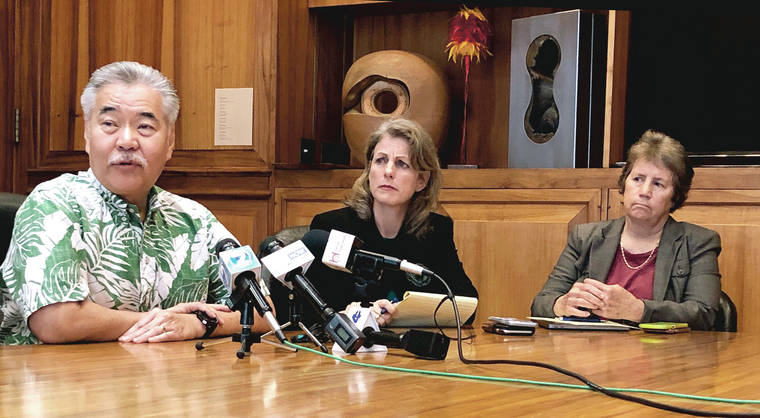After more than five months of waiting, the impasse at Maunakea Access Road has seemingly broken, with Gov. David Ige on Thursday reopening the road and withdrawing law enforcement from the mountain.
The decision, which Ige announced at a press conference Thursday morning, came after being informed by representatives of the Thirty Meter Telescope project that they are not prepared to begin construction of the telescope in the foreseeable future.
“The conditions are not right for us to begin construction,” Gordon Squires, TMT vice president for external relations, told the Tribune-Herald Thursday. “We don’t know when those conditions may change, but if the road were to be open to us tomorrow, we would not be prepared to start construction.”
Squires said the project is still committed to finding a way forward to begin construction on Maunakea, which has long been the preferred site for the telescope. However, he said, it has become clear to TMT stakeholders that the TMT project has prompted many important conversations about Hawaiian rights and other issues that need to be resolved before the project can proceed.
“These conversations take time,” Squires said. “But what we’ve heard across the state is that Maunakea is for everyone. And people want to go up and enjoy the snow.”
Squires said the project remains in conversation with state officials about how to proceed, but said he does not know what any future arrangement might look like. He added that necessary permits for building on La Palma in the Spanish Canary Islands have been granted, but that site remains inferior to Maunakea’s summit.
“I’m an optimistic person,” Squires said. “I’m hoping we can find a good way forward.”
Ige said that, based on the TMT project’s assessment, he felt it is prudent to remove state law enforcement personnel from the mountain in an effort to “de-escalate” the situation at Maunakea Access Road, where opponents of the TMT project — who call themselves kia‘i, or protectors of Maunakea — have camped in protest since mid-July.
Shortly after Ige’s announcement, Mayor Harry Kim said that county law enforcement also will step down its enforcement efforts in the area by 3:30 p.m. today.
“I’m not saying we won’t be doing traffic enforcements on Saddle Road,” said Hawaii County Police Chief Paul Ferreira. “We’ve always done traffic enforcement on Saddle Road. But we’ll be moving officers down to do more enforcement around the island, especially for the holidays.”
Ferreira said state personnel have removed the concrete barricades from the highway, and have had discussions with the protesters about vacating the access road.
Cindy McMillan, communications director for Ige’s office, said the state also removed the temporary traffic light from the access road in order to repair a malfunction. The light may be reinstalled at the access road if it is deemed necessary for public safety.
However, while the access road is legally reopened, it has not been cleared. Ige said at the press conference that he would encourage the protesters to remove themselves from the road, but added “I can’t speak for them.”
A statement from the office of Mayor Harry Kim said that the county is “working to establish communication with the kia‘i to address the current situation.”
However, the protesters themselves reported that Lino Kamakau, branch chief of the Department of Land and Natural Resources Division of Conservation and Resource Management, had told them that they have until Dec. 26 to leave the access road or face arrest.
“(Kamakau) is proposing that we remove ourselves from the road, with these structures, within one week,” said protest leader Kahookahi Kanuha.
In a video posted on the protesters’ Facebook page, Kanuha claimed that Kamakau had implied that the state will use force to clear the road on Dec. 26.
“The governor repeatedly said he wouldn’t disclose operational details,” according to a statement from Ige’s office. “We can confirm that law enforcement officers on-site continue to talk with the protesters about restoring full public access on Maunakea Access Road.”
Without a clear plan for reopening the road, and with no promise that the TMT project is leaving the island, the protesters seemingly do not intend to leave their camp.
“Our position has not changed,” Kanuha said. “We remain as committed as ever to protecting Maunakea from desecration. … And until we hear with our own ears or read with our own eyes that TMT has made a decision to leave Hawaii and go somewhere else in this world or this galaxy, we will be here.”
Kanuha went on to say that the camp will not impede members of the public attempting to ascend the mountain.
The tents on the road have been shifted to the side to allow vehicles to pass.
He advised motorists to drive with caution.
University of Hawaii president David Lassner said the University will continue to support the TMT project.
“The University of Hawaii acknowledges the reduction of state law enforcement presence on Maunakea initiated by Governor David Ige … ,” Lassner said in a statement. “These past months have been difficult for everyone, and we deeply hope this provides a period of reflection for all to continue to seek a positive, peaceful and nonviolent path forward on Maunakea and for Hawaii.”
Email Michael Brestovansky at mbrestovansky@hawaiitribune-herald.com.

